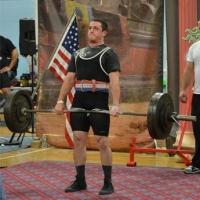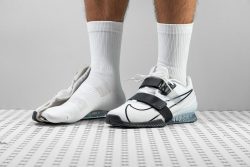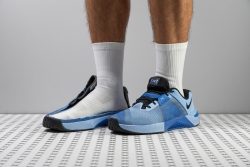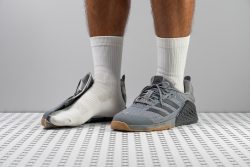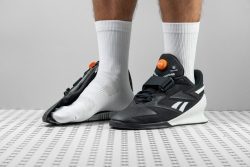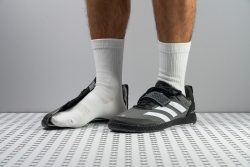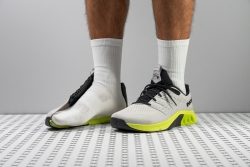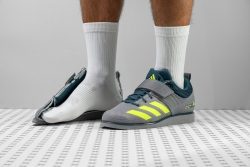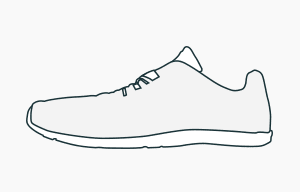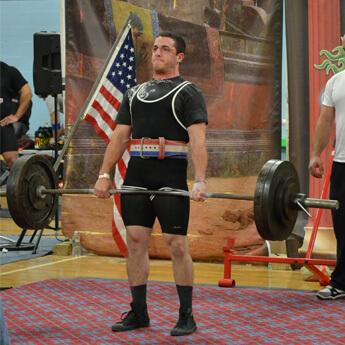7 Best Weightlifting Shoes in 2025
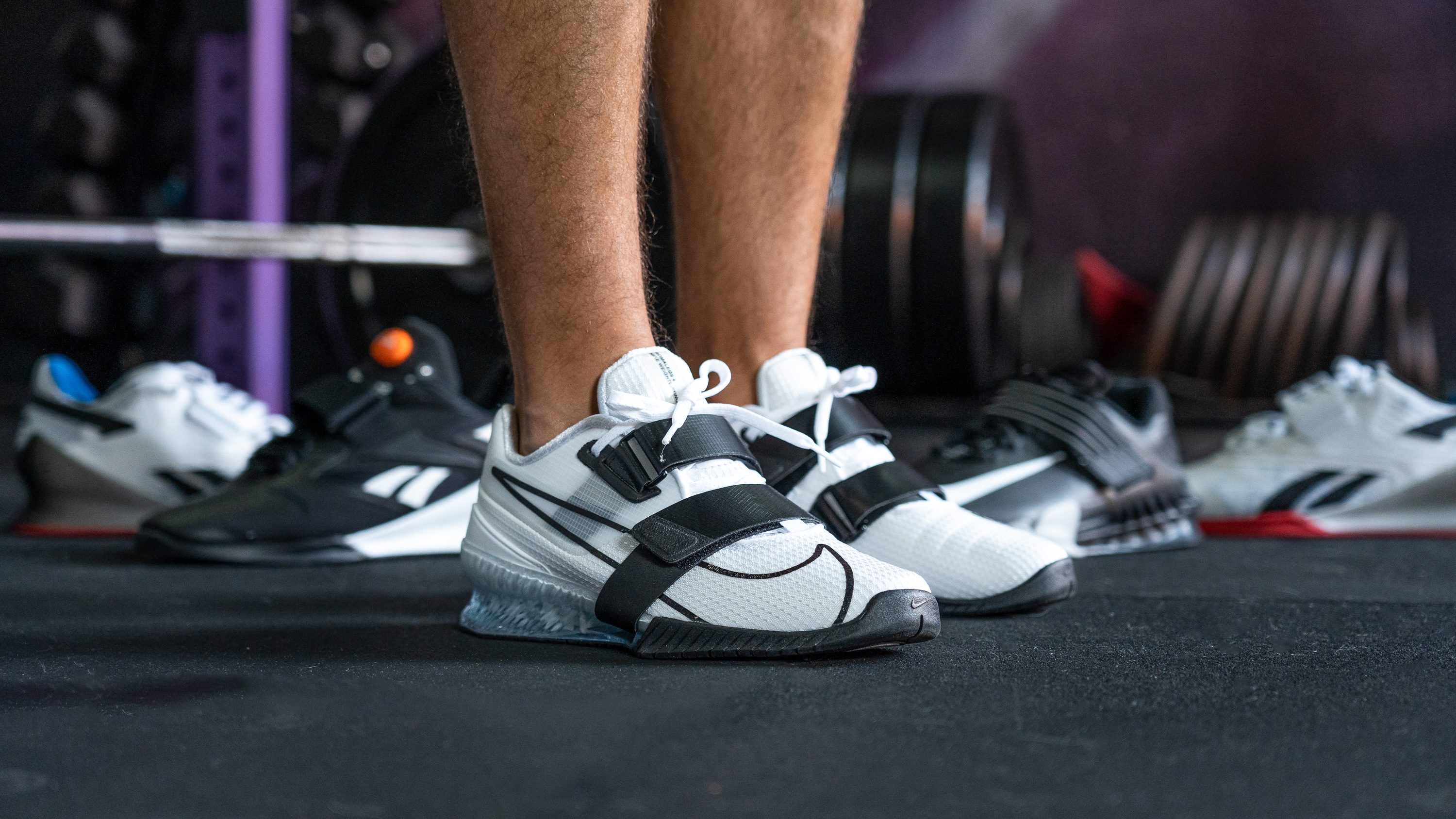
We buy shoes ourselves. We earn commissions when you buy through us, at no extra cost. Why trust us
Also known as lifters or squat shoes, weightlifting trainers stand out with their wide, non-compressible platforms, raised heels, and sturdy uppers, which keep you stable under the heaviest loads.
Whether you are a competitive athlete or a regular gym goer, these shoes are designed to keep you surefooted in every lifting scenario.
While they may all look similar at first glance, there are differences that make some of them better for beginners, advanced athletes, and certain types of exercise. We have tested every lifting shoe in our lab to help you find the best option.
How we test weightlifting shoes
We are on a mission to help you find the best footwear for your lifting sessions. Thus, we take the process of shoe testing very seriously. Here is our approach:
- We buy every lifting shoe with our own money. No sponsorships, no censorships.
- We test each pair of lifters thoroughly doing multiple reps and sessions to understand the performance of the shoe fully.
- In our lab, we further check each shoe's platform height, width, stiffness, and durability, among 20 other parameters. We go as far as cutting shoes in half for a full perspective.
Best weightlifting shoes overall
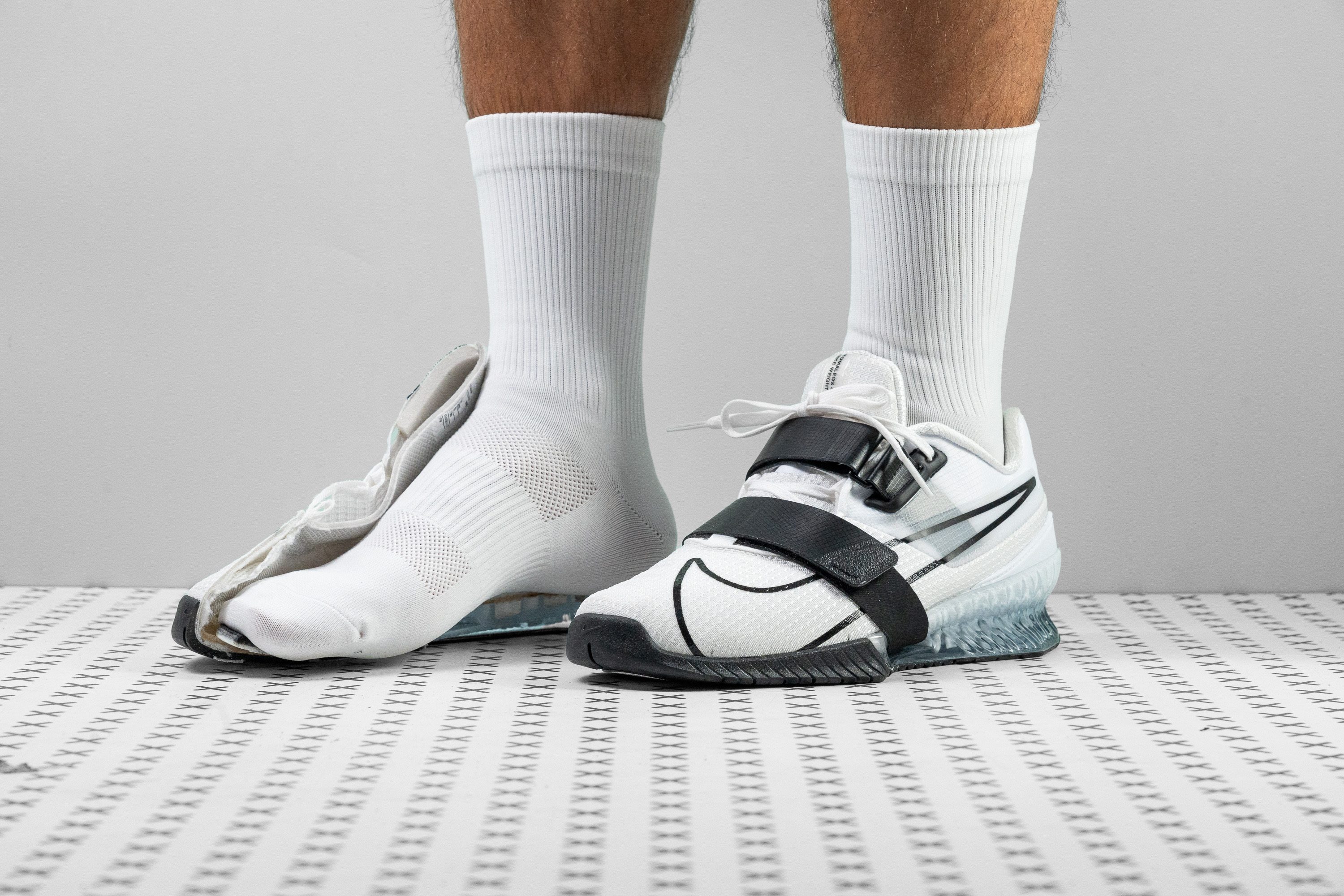






























What makes it the best?
The Romaleos 4 was arguably the firmest that we’ve tried, so underfoot wobbliness easily became a thing of the past. This shoe has not one but two straps that kept our feet securely mounted on the footbed even as they splayed with the weight that we were lifting. Finally, this shoe’s elevation is as lifting-friendly as advertised. Given all these amazing benefits, we are left with no other choice but to consider the Nike Romaleos 4 as the best shoe for weightlifting.
After bringing it to the lab, we were able to confirm the underfoot firmness that we experienced. Compared to the average (75.0), this shoe has a really high HA durometer score of 97.0. That’s a staggering 29% more hardness! And this platform surely kept us quite stable even as our cleans and jerks become a little more aggressive.
We also enjoyed the two-strap design so much, especially that these straps face the opposite directions. Wearing this shoe just felt like our feet were being bear hugged, making them stay firmly still.
The Nike Romaleos 4 was advertised to have a drop of 19.05 mm. We were glad when the calliper showed that the marketing spiel is more or less accurate. The actual drop is 20.5 mm, which was a big help in maintaining a good upright posture during lifts.
We are just not happy with the fact that the upper material is not the most durable. We subjected the toebox to 12 seconds of drilling during our Dremel test, resulting in an unfortunate hole.
Pros
- Phenomenal stability
- Sturdy platform and sole
- Better lockdown with two straps
- Comfortable for a lifting shoe
- True to size
- Efficient traction
- Appealing looks
Cons
- Upper lacks durability
- Not for narrow ankles
- Not breathable
Best cross-training shoes for lifting
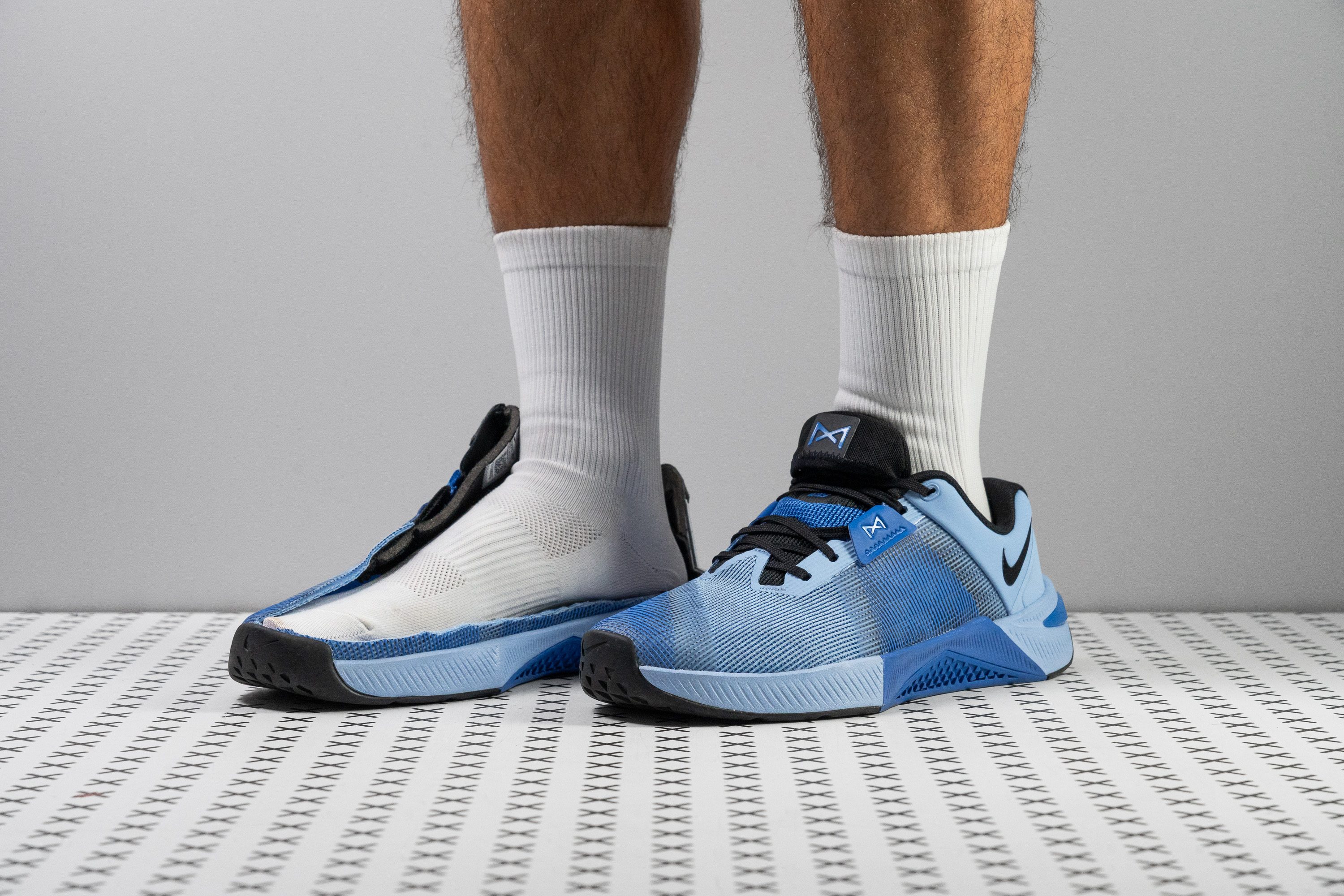














































What makes it the best?
Among weightlifting shoes, we found the Nike Metcon 10 to be the top cross-trainer because it effectively stabilises us without having a very stiff construction. As confirmed by lab tests, its adaptive build allows us to perform a wide range of workouts with ease.
It didn’t take much effort to perform foot-bending exercises such as planks and burpees. Our bend test shows it’s even 13.2% more flexible than the average trainer, which is very impressive given the shoe’s unwavering support.
Speaking of support, Metcon 10 features a low and solid base that keeps us well-planted. Our calliper shows it’s only 22.8/16.2 mm, giving us ground feel and enhanced control. It features a firm Hyperlift in the heel that doesn’t collapse under heavy weight. Together with its wide 115.2/90.8 mm base, we felt sure-footed even while lifting PR loads.
Despite its solid stability, it didn’t weigh us down and is only 11.0 oz (312g), which helped us feel nimble during drills and quick footwork.
However, its limited ventilation had our feet gasping for air during heated sessions. Those seeking maximum airflow should go for breathable trainers.
Pros
- More versatile Metcon overall
- One of the lightest Metcons ever!
- ReactX adds shock absorption and energy return
- Increased forefoot flexibility
- Still amazingly stable for weightlifting
- Fantastic upper durability (even for rope climbs)
- Great grip on gym floors
- Highly secure foot lockdown
- Accommodating fit and toebox
- Handy Lace Tuck
Cons
- Outsole could be more durable
- Upper lacks breathability
Best weightlifting shoes for beginners
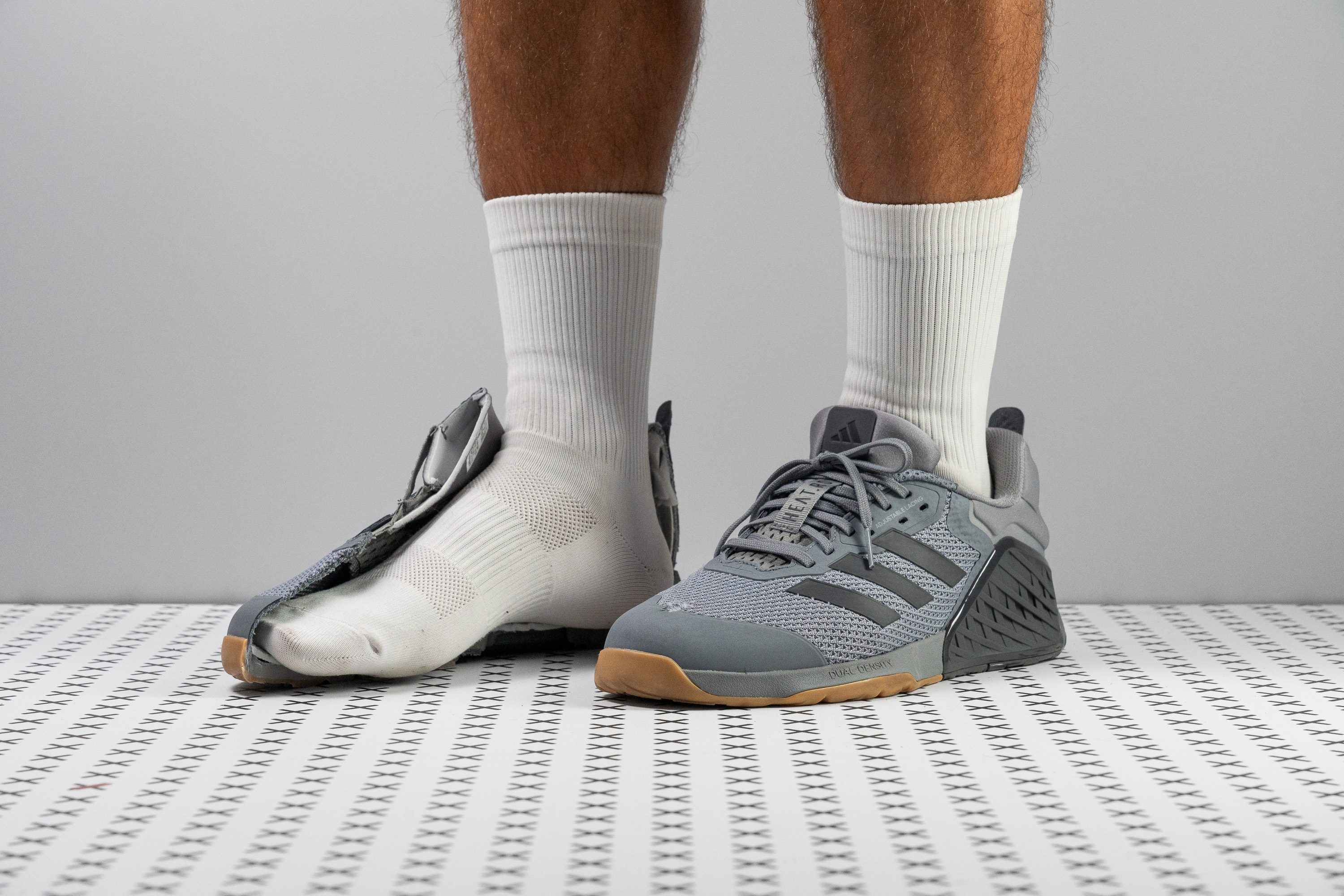






















































What makes it the best?
The Adidas Dropset 3 made sure we felt fully in control of our movements while lifting in the gym. Our lab tests validate that it offers a secure platform, a comfy yet firm foothold, and grip-assured footing. Because of all these and more, it’s our top weightlifting shoe for beginners.
The forefoot delivers a feedback-rich sensation, and our calliper shows its thin 14.8 mm cushion. The midsole features a dual-density setup: a soft 21.5 HA foam in the forefoot for comfort and a very firm 41.0 HA heel. The rear is 47.5% harder than average, which almost makes it impossible to collapse under heavy weight.
Our stability is further enhanced through the shoe’s firm rubber overlay on the medial side. Plus, it holds our ankles in place without any discomfort thanks to the GeoFit Sensepods.
In addition, the forefoot runs wider than average at 116.9 mm, allowing us to stay well-planted. Underneath, it delivers solid grip through its Adiwear outsole. This confidence-inspiring traction is crucial in maintaining our balance.
The shoe feels more forgiving than dedicated lifting shoes because of its flexible build. Those who prefer more reinforcements should try another pair.
Pros
- Exceptional stability for lifting and lateral movements
- Very wide and grounded platform
- Extra durable and grippy outsole
- Very secure foothold
- Flexible enough for plyometrics
- Fantastic breathability
- Accommodating toebox
Cons
- Not great for running and walking (clunky heel)
- Can't be worn outside because of sole apertures
Best weightlifting shoes for advanced athletes
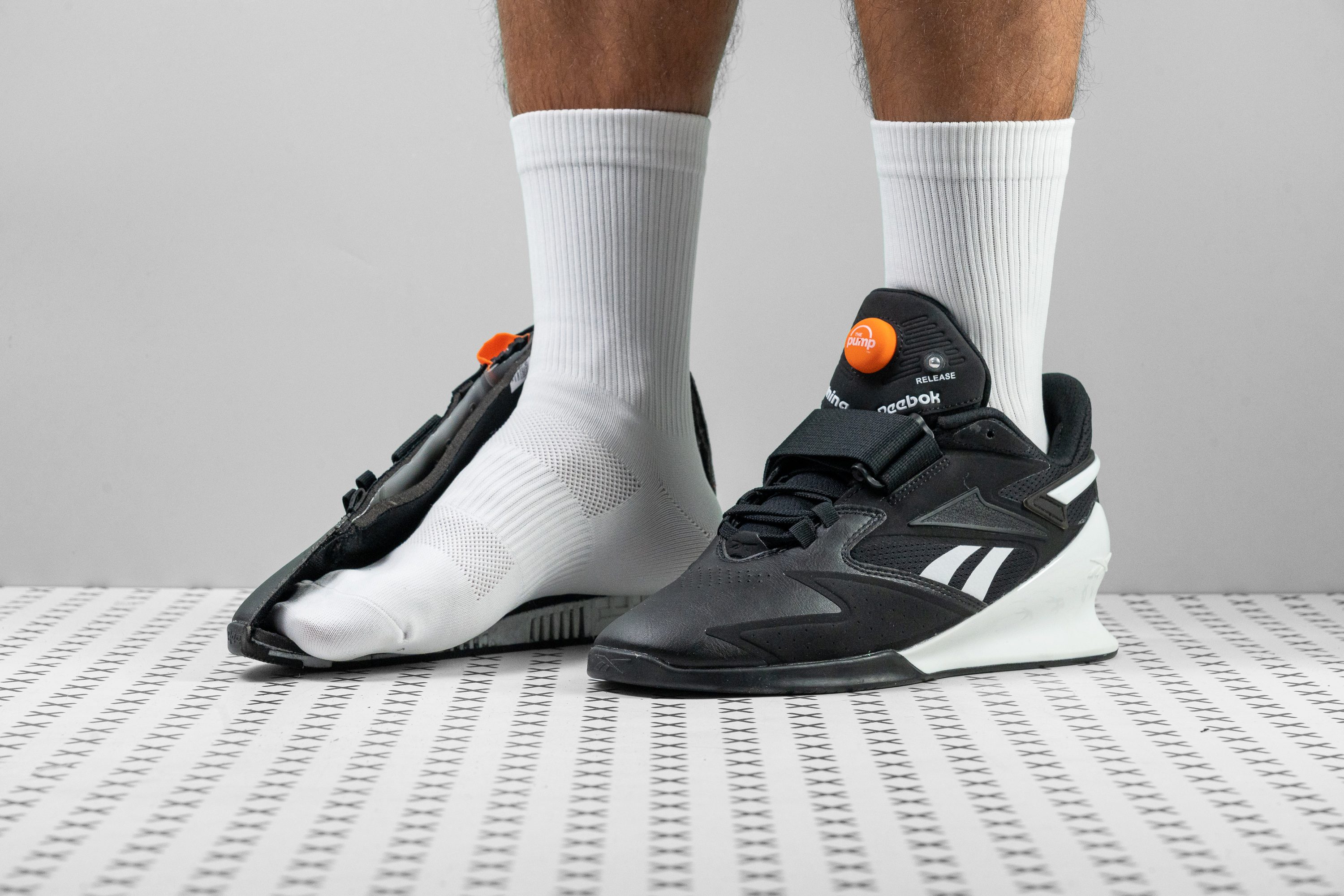





































What makes it the best?
If you are an advanced lifter, then we are 100% sure that you are going to love the Reebok Legacy Lifter III. This shoe is the best that we can offer to anyone who is already on top of their weightlifting game. Besides its immense durability, we are in awe of the amount of stability that it was able to deliver. We also loved how the shoe’s perfectly elevated heel helped with our form during squats and lifts.
In the lab, we subjected the toebox to our merciless Dremel. But the drilling came out to be just a joke for it! The ‘merciless assault’ (or so we thought) barely left a mark on the toebox! Hence, the perfect that we gave this shoe for toebox durability was pretty much well-deserved.
In terms of stability, we think that nothing can beat the Reebok Legacy Lifter 3 at this point. Both the shoe overall structure and heel counter were immensely resistant to our manual twisting and squeezing. Both parts got a perfect 5 from us for their amazing rigidity.
Based on calliper measurements, the heel stack is higher than average (28.3 mm) at 33.0 mm. We were so in love with this because it helped us maintain a good posture when lifting and squatting. The elevated heel helped with ankle mobility as well.
If there is one thing that we want to change, it would be the airiness of this shoe. We have to admit, this one was quite a toasty one. It only got a 2 out of 5 in our breathability tests.
Pros
- Mind-blowing stability
- Incompressible platform
- High heel helps with posture for squats
- Highly supportive upper
- Top-notch durability
- The Pump feature is fun and improves the fit
Cons
- Unreasonable price hike
- Short Velcro attachment
Best weightlifting shoes for deadlifts
















































What makes it the best?
In our lifting sessions, Adidas The Total stands out as a reliable choice, ensuring safe and efficient lifts. Through rigorous lab tests, we found that its zero-raised heel and exceptional ground feedback make it particularly well-suited for deadlifts compared to other weightlifting shoes we've tried. With its spacious toebox and grippy outsole, we felt stable and coordinated while executing the "king of lifts" with proper form.
The low, firm, and levelled stack of The Total contributes to effortless and smooth deadlifts, enhancing sensitivity to the surface. Our measurements reveal a below-average 12.5 mm stack height with zero heel drop, accompanied by a 44.4% firmer-than-average durometer reading. We gained more control to nail the technique and activate the right muscle groups to perform deadlifts efficiently. With a strap that holds our foot firmly, we remained planted to the ground for better balance.
The shoe's vast platform facilitates natural toe splay and offers reliable traction across various surfaces, further enhancing stability. The toebox measures wider than average, especially in the 86.5 mm big toe area, and tapers subtly. These elements aid in lifting with the correct form, avoiding slips that may cause back injuries.
However, ventilation is lacking, as indicated by our breathability tests, which yielded a low 2/5 score.
Pros
- Ideal for deadlifting
- Great traction
- A lot of ground feel
- Plenty of toebox space
- Lightweight and comfortable
- Fairly priced
- Streamlined look
Cons
- Not so much breathability
- Not for heavy squats
Best hybrid weightlifting shoes
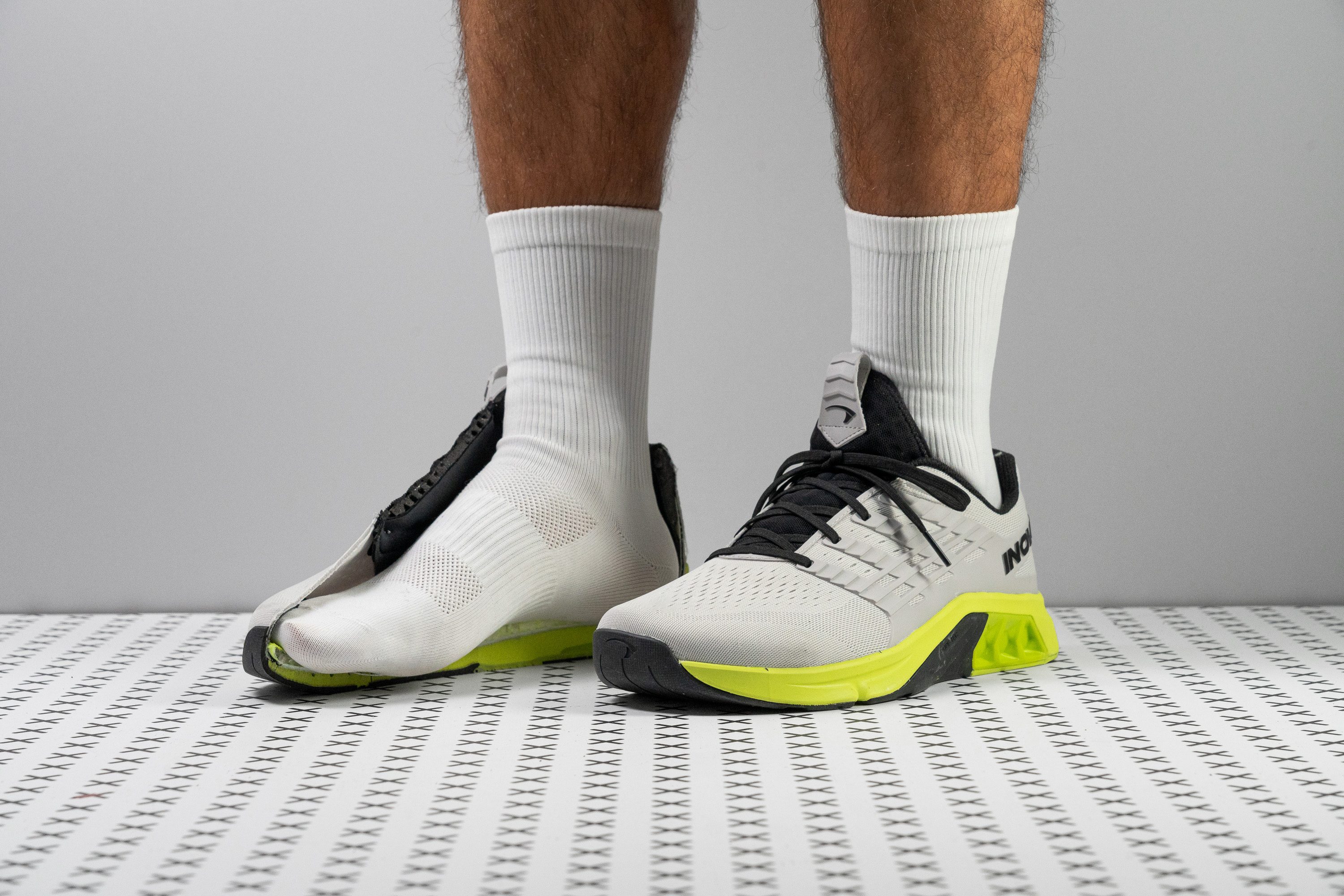























































What makes it the best?
The Inov8 F-Lite Max blends sturdy support and some give in the right areas, making it stable for strength training and versatile enough for jumps and plyometrics. Our lab results confirm it’s our top hybrid weightlifting shoe because of its surefooted base, flexible forefoot, and locked-in feel.
Using our durometer, we measured the main cushion at a firm and supportive 35.0 HA. The forefoot felt pleasantly responsive for takeoffs under the balls of our feet. Meanwhile, the heel incorporates a hard-packed TPU, measuring a very firm 88.0 HA for heavy weights.
In the midfoot, the Met-Cradle cradles our foot in position, making it less prone to toppling over while performing dynamic movements. Through manual twisting, we discovered it has a high resistance so we rated it with a 4/5 torsional rigidity score.
Thankfully, the forefoot is more forgiving. Measuring 5.5% more flexible than average in our bend test, we found it easy to perform lunges, planks, and other workouts.
Note that F-Lite Max has an extra-wide toebox, so we cannot recommend this pair to people with narrow feet.
Pros
- Fantastic stability for lifting and Crossfit
- Great for heavier lifting (stiff TPU heel)
- Awesome for wide feet
- Good forefoot flexiblity
- Highly breathable toebox
- Solid outsole durability
- Protection for rope climbs
- The stickiest outsole rubber
Cons
- Heavier than average
- Clunky and firm for HIIT/cardio
- Frail upper fabric
Best value weightlifting shoes
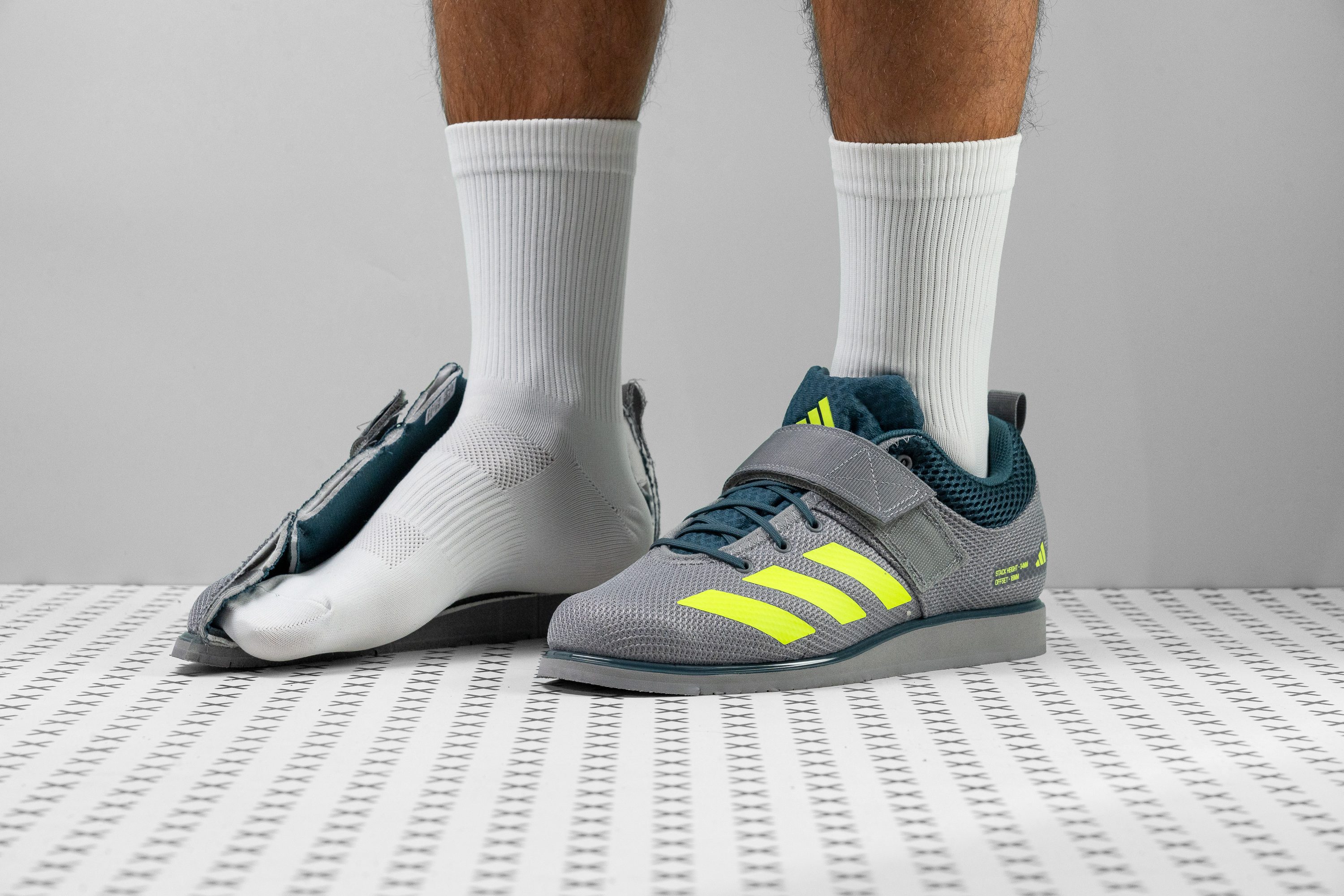














































What makes it the best?
The Adidas Powerlift 5 offered so much for its price, and it was still cheaper than the £150 average for weightlifting shoes at £120 a pair! It felt so light, quite supportive at the heel, and offered one of the thickest outsoles ever.
Compared to the average (18.7 oz or 531g), the Adidas Powerlift 5 is 3.7 oz or 105g lighter. This is a huge deal, especially for novice lifters who are just getting used to wearing specialised shoes like this one.
The heel counter is truly dependable. We felt its secure clutch the moment we put it on. After giving it a good squeeze in the lab, we had no other choice but to give it a perfect 5 for its amazing stiffness.
Using a calliper, we learned that the outsole is actually 5.0 mm thick, making it one of the thickest weightlifting outsoles we’ve ever seen (average is only 3.9 mm). Given that the outsole is generally as durable as others, its thickness is a guarantee for it to last longer simply because there is a lot more material to ‘burn.’
It’s just too regrettable that the toebox isn’t as spacious. At its widest part, the calliper measured it to be only 95.2 mm when the average is 98.9 mm, or a difference of 3.7 mm! That’s huge!
Pros
- Stable base for moderate lifting
- Good for accessory exercises
- Solid bite on gym floors
- Secure foothold
- Supportive Velcro strap
- Reasonably priced
- Contains sustainable materials
Cons
- Lacks breathability
- Upper is not very durable
- Tongue shifts
Why get a weightlifting shoe
Many gym-goers lift weights using whatever footwear is at their disposal, even regular running shoes and casual trainers. Although these types of shoes could suffice for dumbbells and kettlebells, wearing them for a loaded barbell can be dangerous!
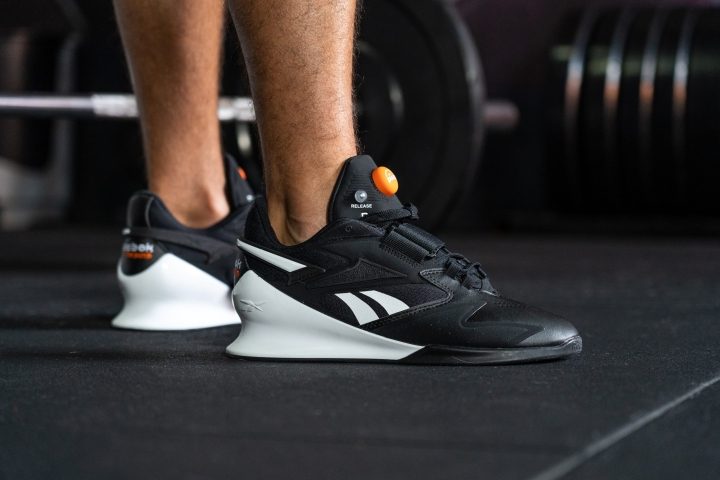
There are several solid reasons for considering specialised weightlifting shoes.
Proper squat posture
- The elevated heel (from 15 to 21 mm) helps the wearer squat deeper in an upright position without stressing the ankle or the Achilles tendon.
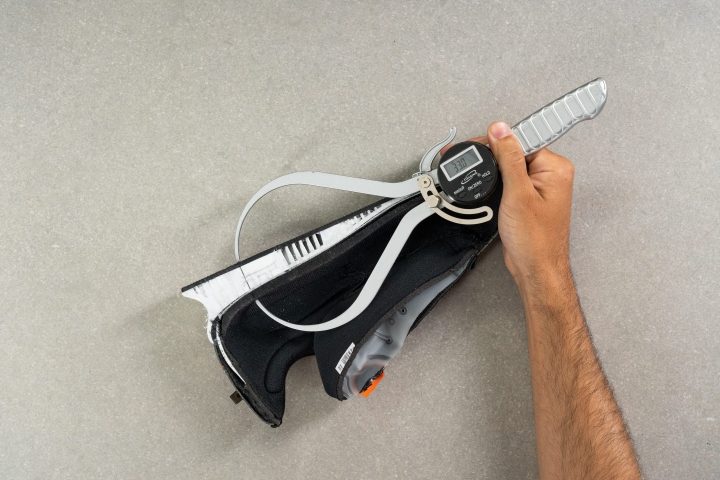
| Average drop | Range of drop | |
| Weightlifting shoes | 18.4 mm | 15 - 21 mm |
| Cross-training shoes | 5.9 mm | 3 - 12 mm |
Stable platform
- The highly rigid construction doesn't let the wearer's feet or ankles twist sideways.
- The hard, non-compressible platform prevents energy loss when pushing the weight up.
- torsional rigidity (by twisting the shoe sideways)
- platform firmness (by pressing an HA durometer against the half-cut midsole/platform)
Based on our extensive lab data, weightlifting shoes are 150%(!) firmer than cross-training shoes!
| Average platform firmness | Average torsional rigidity | |
| Weightlifting shoes | 69.1 HA* | 4 out of 5** |
| Cross-training shoes | 27.5 HA | 3 out of 5 |
*higher HA measurement means firmer; **5 is the stiffest possible
Secure foothold
- Extra-sturdy upper materials keep the foot firmly in place.
- Wide Velcro straps or BOA dials are added to adjust the fit and hold it at all times.
- A firm heel counter at the back stabilises the rearfoot area.
If these benefits are not convincing enough, see our extensive science-backed guide to lifting shoes. Here we elaborate on the pros and cons of lifting barefoot, in a running shoe, and even in a flat shoe like Converse Chucks.
Lifting shoes vs. cross-training shoes
But what if you are not aiming for the professional tournaments? You just want to incorporate some lifting into your regular gym session. In this case, a pair of cross-trainers or CrossFit shoes may indeed be a better option.
Here is the quick answer:
|
If squats, cleans, and jerks are the primary focus of your gym routine and you want maximum stability from your shoes, choose lifters. If you want to be more versatile, do all-around workouts, and don’t want to change footwear amid a training session, go for the cross-trainers. |
But let’s consider the pros and cons of each type in more detail:
|
Lifter
|
Cross-trainer
|
|
Very high heel-to-toe drop: 15 - 21 mm |
Moderate heel-to-toe drop: 5-8 mm |
|
Pros:
Cons:
|
Pros:
Cons:
|
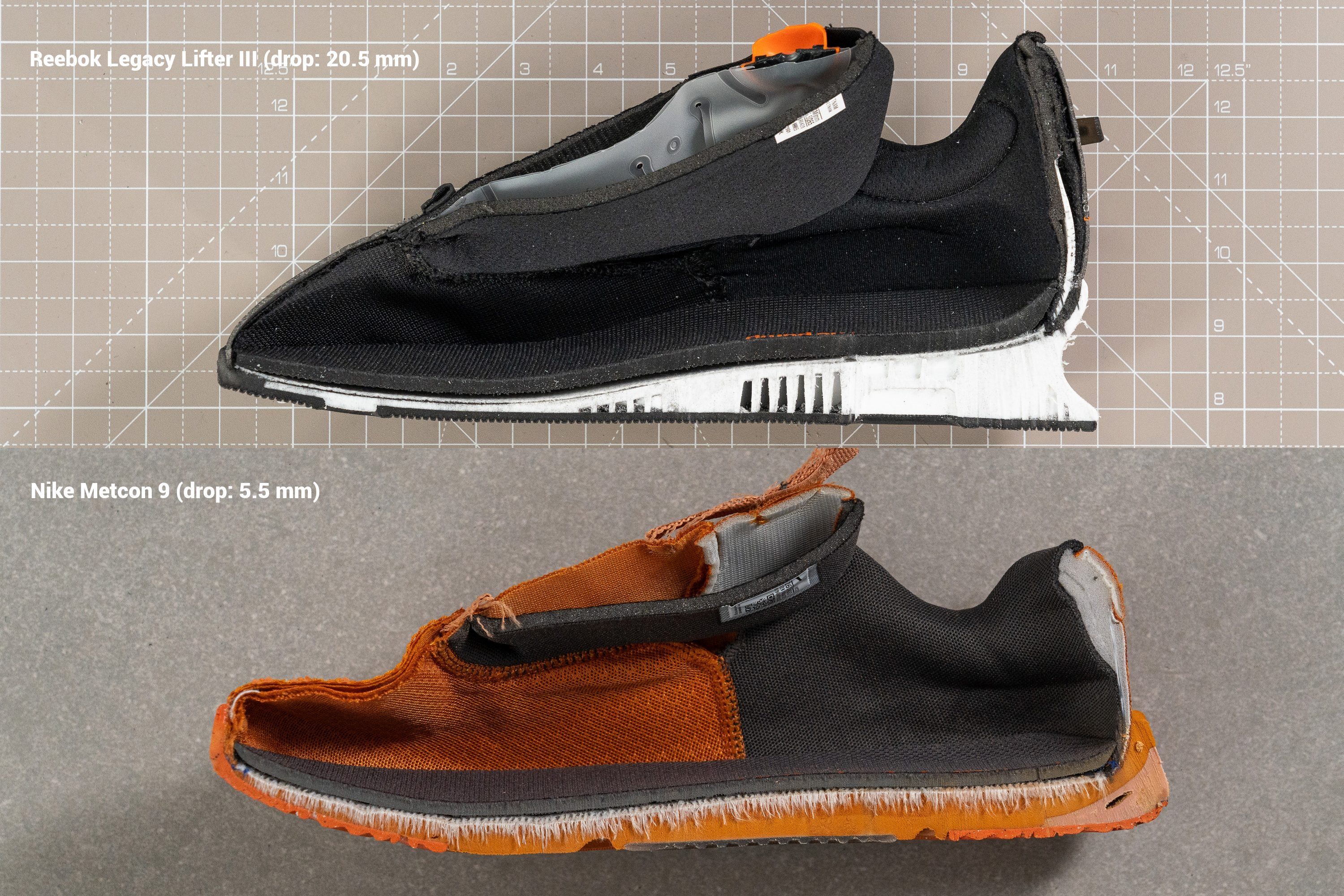
|
Lifter: Non-compressible sole |
Cross-trainer: Moderately compressible sole |
|
Pros:
Cons:
|
Pros:
Cons:
|

|
Lifter: Very rigid construction |
Cross-trainer: More flexible construction |
|
Pros:
Cons:
|
Pros:
Cons:
|

We measure how much force it takes to bend each shoe to a 30-degree angle. Our lab data shows that lifting shoes are 35% stiffer than cross-trainers.
How to choose the right weightlifting shoe for you
The primary parameter to consider in lifting shoes is the heel-to-toe drop or the difference in height between the heel and the forefoot.
In lifters, the drop ranges from 15 mm (0.6 in) to 21 mm (0.8 in).
Lifting shoes for beginners
Because the higher heel takes some adjustment, there is a tendency for beginners to select the lower height (15-16 mm).
Hybrid shoes like the Nike Savaleos are great for beginner athletes as they come with lower heels and a more flexible forefoot to accommodate exercises other than lifting (P.S. not good for cardio though).
Lifting shoes for seasoned athletes
If you squat and lift over 350 lbs regularly, you will benefit from a lifter with the highest heel elevation (20-22 mm).
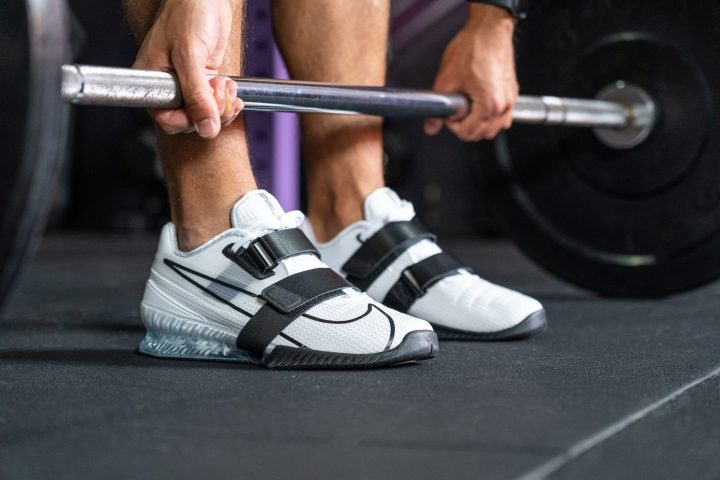
Deadlifting shoes
In rare cases, you will see lifting shoes with a 0 mm drop and a very thin sole. These shoes are optimised for deadlifting.
Advanced athletes prefer this setup when the weight is in front of them (as in deadlifting) as it provides the most optimal body position as opposed to elevated heels which are better for squats or when the weight is overhead.
